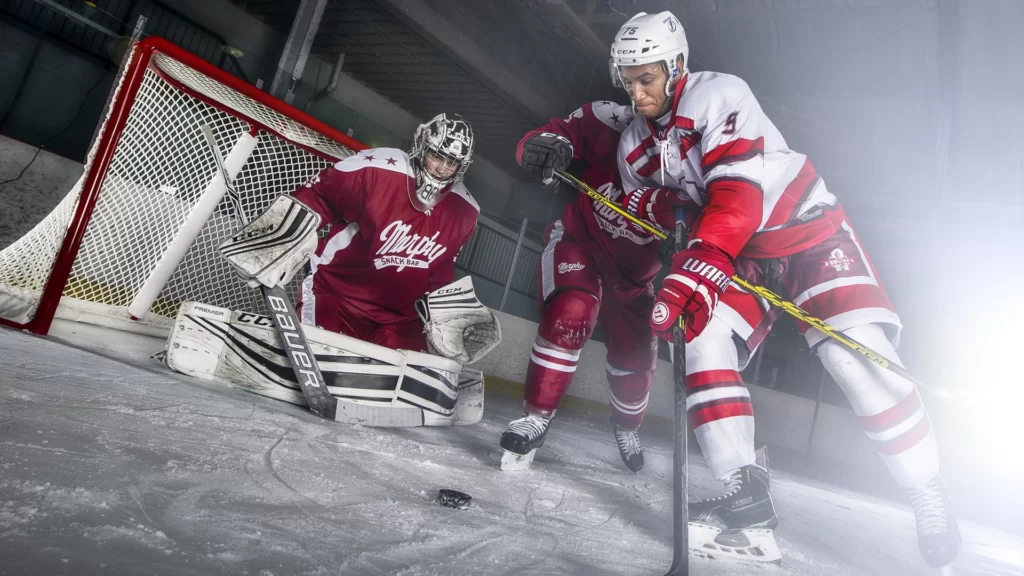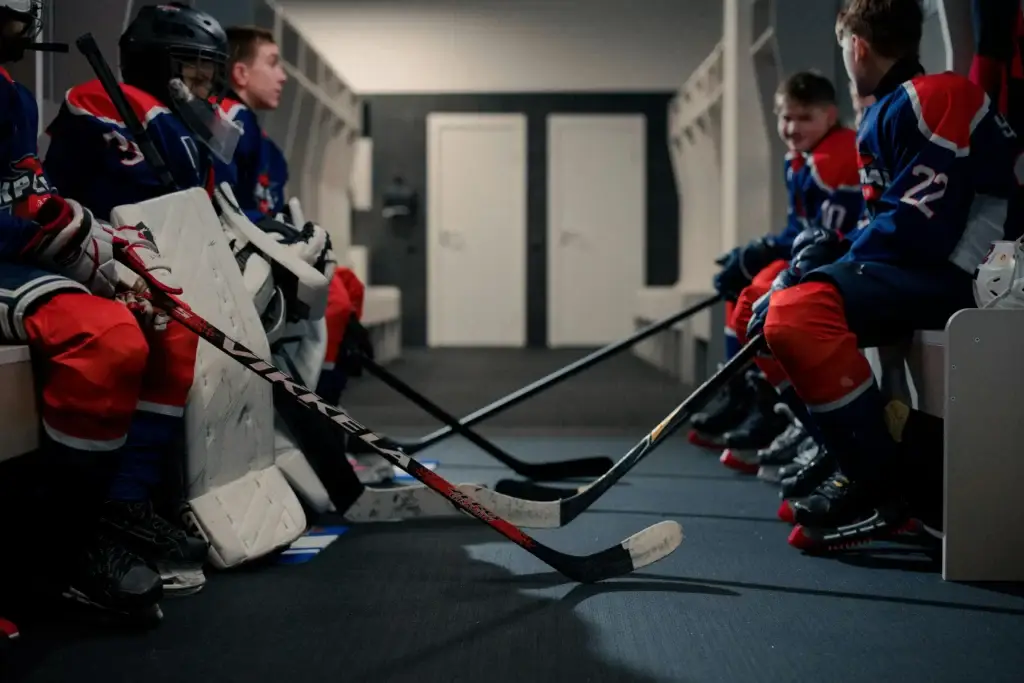The chronicle of the battles on the ice does not begin with rampant puck strikes, but with the first cautious steps on the ice. No one could have imagined that the game that began in backyards with homemade goals would become a national passion and a symbol of Russia.
In this article, we tell the fascinating story of the development of ice hockey, all the way from the ice stadiums to the biggest arenas in the world.

History of ice hockey in Russia
Stages in the development of ice hockey in the Russian Federation – not just ice, sticks and puck. Ice hockey is part of the cultural heritage, a symbol of struggle, spirit and bravery. The first domestic game took place on the territory of St. Petersburg in 1897. The game with the puck, which came from Canada, quickly found favour with Russian winter sports enthusiasts.
The origins of ice hockey
The first attempts to create ice hockey began at the beginning of the twentieth century. The development of ice hockey is due to enthusiasts such as Peter Ivanov, who founded one of the first themed clubs in Moscow in 1932. The emergence and popularisation of ice hockey ran parallel to the development of society, and during the Soviet years the sport became a powerful ideological symbol, symbolising not only sporting achievements but also the strength and spirit of the nation as a whole.
Ice hockey in the USSR
In Soviet times, the games on the ice became a real source of pride. The USSR team repeatedly won the Olympic Games and World Championships. One of the most famous moments is the 1972 Super Series, a historic meeting between the USSR and Canada that was a true clash of sporting titans. Players like Vladislav Tretiak and Valery Kharlamov became true legends and idols to millions. The history of ice hockey here is interwoven with the milestones of the country’s past and has become an important part of the national culture.
Development of ice hockey in Russia
With the collapse of the USSR, the sport faced new challenges. The economic difficulties of the 1990s hit funding hard, but this did not dampen the country’s spirit. On the contrary, it was during this time that the new Russian Continental Ice Hockey League (KHL) was founded, which is now one of the leading leagues in the world.
Economic change and the founding of the KHL
The new economic reality required innovative approaches to sport. Private sponsors began to play a key role in the development of ice hockey. The KHL was founded in 2008, and since then many well-known clubs such as ZSKA and Salavat Yulaev have joined. With the establishment of the KHL, the country not only returned to the world stage, but also gained new opportunities for the development of young talent. The formation took a new path, in which the game took on a different form and scope.
The first ice hockey games in the new Russia
One of the outstanding events of this period was the first KHL match between Salavat Yulaev and Lokomotiv in 2008, which symbolised a new stage in the niche. This encounter marked the return of domestic teams to the international stage and showed that the country was once again ready to fight for supremacy. The history of ice hockey continues to grow and develop, becoming an important part of Russian sports culture.
Legends of Russian ice hockey
 The chronicle is full of colourful names and events. Famous hockey players of the past have become true symbols of the nation, and their merits continue to inspire new players. Valery Kharlamov, Alexei Kasatonov, Sergei Makarov – names and surnames that have gone down forever in the history of Russian ice hockey.
The chronicle is full of colourful names and events. Famous hockey players of the past have become true symbols of the nation, and their merits continue to inspire new players. Valery Kharlamov, Alexei Kasatonov, Sergei Makarov – names and surnames that have gone down forever in the history of Russian ice hockey.
Valery Kharlamov: Legend number 17
Kharlamov became a symbol of Soviet ice hockey history thanks to his speed, technique and unwavering determination. His play in the 1972 Super Series against Canada was a true work of art that is still replayed by coaches and players around the world today. The power of his shot and his incredible feel for the ice made him a legend.
Alexei Kasatonov and his contribution
Kasatonov, for his part, was known as one of the best defencemen. As a player alongside Vyacheslav Fetisov at ZSKA and in the USSR national team, he became a role model and a benchmark for excellence. The history of ice hockey in the Russian Federation is unthinkable without these names, who inspired the future generation of ice hockey players.
Hockey stadiums and equipment
Without modern arenas and high-quality equipment, this sport would not be possible. It all started with small open-air ice rinks, but over time large sports complexes were built: the Ice Palace in St. Petersburg and the VTB Arena in Moscow.
Development of ice hockey arenas
The first covered arenas were built in the 1960s, when the popularity of ice sports events increased rapidly. Today, there are more than 500 large ice rinks and ice stadiums in Russia alone, many of which meet international standards and can host international competitions. Ice stadiums have become an integral part of urban infrastructure, a place where emotions run high and legends are born.
Ice hockey equipment
Equipment has evolved from simple wooden shields and woollen jerseys to modern composite materials that offer maximum protection and freedom of movement. Modern equipment includes helmets with protective visors, hard-wearing gloves, shields and overalls that offer protection against heavy puck impacts. These elements help to ensure a high level of safety during the game.
Hockey rules and interesting facts from the history of Russian hockey
The rules are the basis for keeping the game dynamic and spectacular. But few people realise that the standard rules have undergone significant changes since their introduction.
The modern set of rules contains numerous regulations designed to ensure the safety of the players and maintain the spirit of competition. One of the most important rules is the offside rule, which was introduced at the beginning of the 20th century. It prevents unfair advantages and maintains the tempo of the game. Standards help to keep the game exciting and fair for all participants.
Interesting facts:
- The first game in Russia was played on the open ice of St Petersburg in 1897.
- The longest ice hockey game in history took place in 1936 and lasted over six hours!
- Vladislav Tretiak, the famous goalkeeper, was a three-time Olympic champion and is considered by many to be the best goalkeeper of all time.
Conclusion
 Sporting contests on the ice are more than just a sport in the Russian Federation. It is a symbol of national pride, unity and struggle. The history of Russian ice hockey is a chronicle of overcoming difficulties, victories and defeats that have shaped the character of the nation. Today’s generations continue the traditions of their predecessors and play on the ice with the same passion as the legends of the past.
Sporting contests on the ice are more than just a sport in the Russian Federation. It is a symbol of national pride, unity and struggle. The history of Russian ice hockey is a chronicle of overcoming difficulties, victories and defeats that have shaped the character of the nation. Today’s generations continue the traditions of their predecessors and play on the ice with the same passion as the legends of the past.

 en
en  ru
ru  de
de  ar
ar  es
es  hi
hi  fr
fr  nl
nl  it
it  pt
pt  el
el 



